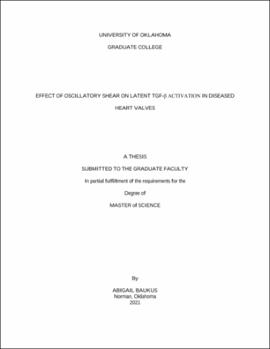| dc.description.abstract | Calcific aortic valve disease (CAVD) is the second leading cause of heart surgery and is responsible for about 15,000 deaths per year in North America. CAVD involves the thickening and calcification of the leaflets that comprise the aortic valve—as this occurs, the blood flow through the valve becomes disturbed and creates an environment of oscillatory pathological shear stress. The regulatory cytokine TGF-β1 is activated by shear stress and its upregulation furthers disease progression by inducing fibrosis and calcification of the cells that comprise the valve. The heart valve is difficult to study directly because of the complexity of its geometry and the heavy computational demands that modeling the valve entails. Therefore, studies have been done looking at the activation of TGF-β1 in steady vs oscillatory shear environments in a cone and plate device. In this report, the CFD software ANSYS Fluent is used to model three different oscillatory profiles in a cone and plate device: rotation of the cone with abrupt stopping, rotation with ramped acceleration/deceleration when changing directions, and sinusoidal oscillation. All three profiles generate similar time-averaged shear stresses (2.8, 2.7, 2.7 dyne/cm2, respectively), but the abrupt stopping case generates a spike in shear stress that is nearly 50% higher than the maximum shear stresses seen in the ramped or sinusoidal cases: 14.6 vs 9.94 and 10.2 dyne/cm2. Simulations were also run using the simpler geometry of parallel plates to validate the findings. It was found that decreasing the “stop time” when the plate’s motion is abruptly stopped by an order of magnitude did not greatly affect the maximum shear stress near the plate (175 vs 169 dyne/cm2 for stop times of 0.10 and 0.01 s, respectively), but it did result in a 3-fold increase in the ramped acceleration case: 43.2 vs 130 dyne/cm2. These trends are independent of Reynolds number and affect about 30% of the fluid domain in the cone and plate device. Therefore, when it comes to modeling the aortic valve directly, the sensitivity of the solution to the boundary conditions depends on two things: if the valve opening and closing occurs in a manner more similar to the abrupt or to the ramped case and the sensitivity of TGF-β1 to large spikes in shear stress. | en_US |
